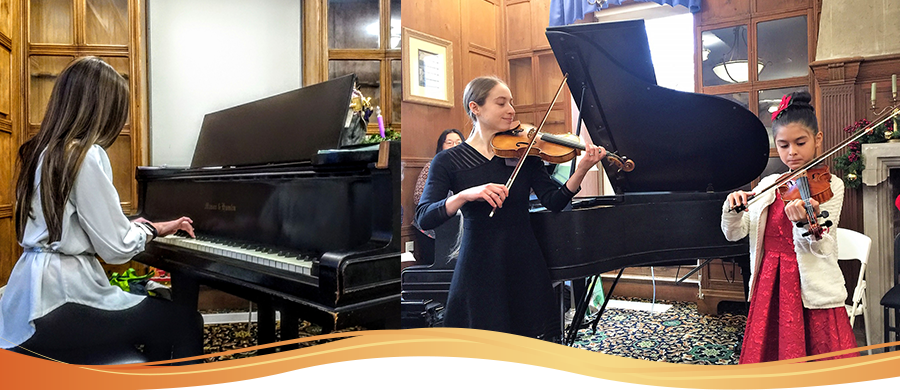
Online
Music for the Community
If you're interested in a particular category, you can sort performances by student age, instrument, singalong music, composer and so on - click on the orange tags under the text. We hope you and your family will enjoy watching our students share their music!
To have each week's videos and accompanying info sent to your inbox*, please subscribe via the orange button.
*Videos are delivered twice weekly; you can unsubscribe at any time, and we will never share or sell your info.
Subscribe to this Page
Displaying items by tag: Cello
Day 49 - Bach Prelude from Suite in G
Violist age 14 and Cellist age 16 play Bach Prelude in G major
Because of their musical and technical difficulty, the Suites were not much performed until the great 20th century cellist Pablo Casals took them up, after discovering them in a thrift shop in Barcelona, Spain at the age of 13. His famous recordings of them were selected in 2019 for preservation in the Library of Congress.
Week of June 1st: Lament
To quote Martin Luther King Jr., "Injustice anywhere is a threat to justice everywhere." As members of communities both smaller and larger, what affects some of us affects all of us, and if we stay silent in the face of egregious injustice, we risk becoming become complicit in it.
"Lament", performed by the composer
Day 38: Bourrée 1 & 2 by Bach
Cellist age 16 plays Bourrées I & II from Bach Solo Suite #3 in C
More old-fashioned dance music today, but unlike a Minuet, a Bourrée (pronounced "boo-ray") is in duple time (ONE two, ONE two) – similar to a Gavotte. Still, like our Minuet and Trio on Day 36, this set of two Bourrées is again made on an overall A B A pattern.
Day 35: Vivaldi Cello Sonata in A minor
Cellist age 15 plays Vivaldi Cello Sonata in A minor
Born in Venice on the day of an earthquake, Italian composer Antonio Vivaldi (1678 -1741) is regarded as one of the greatest composers of the Baroque era, and during his lifetime he was famous across Europe. He composed many instrumental works, especially for string instruments - many of which were written for girls at the orphanage in Venice, whose musical skill improved their marriage prospects at a time when there were few other options for women. He also wrote a large amount of church music, and more than forty operas. His best-known work is the series of violin concertos known as the Four Seasons - we featured "Spring" earlier in this series.
Vivaldi wrote a set of six cello sonatas (works for a solo instrument, usually with accompaniment by a keyboard) between 1720 and 1730. All of them have four alternating slow and fast movements (separate pieces); this is the second movement of the third sonata.
Day 32: Harry Potter
Cellist age 9 plays Harry Potter: Hedwig’s Theme and Fireworks
Day 21: Allegro Appassionato by Saint-Saens
Cellist age 16 plays Allegro Appassionato by Saint-Saens
French composer Camille Saint-Saens (pronounced Sanh-Sonh) was born in Paris in 1835. By the time he was three he was picking out tunes on the piano, and his great-aunt started teaching him. He made his professional debut at the age of 10, and also became a brilliant organist.
His first job was as a church organist, which allowed him time to pursue his interests in piano and composing. He later became a beloved teacher at a school for future organists and choirmasters, and wrote his famous “Carnival of the Animals” with his students in mind (although he didn’t finish it till much later, after he left the school).
Day 15: Haydn Cello Concerto in C
Cellist age 15 plays Haydn Cello Concerto in C, first movement
Day 7: Minuet in C by Bach
Cellist age 11 plays Bach’s Minuet in C
A minuet is an elegant 18th century dance – think ladies in dresses with huge ruffled skirts, and gentlemen in knee britches. This dance in 3/4 time, with small, elegant steps and many bows and curtsies, was all the rage in the fancy ballrooms of Europe (especially France and England) from about 1650 to 1750. Since Bach lived from 1685-1750, this was basically the pop music of his time. See if you can feel the 1, 2, 3, 1, 2, 3 pulse, then get our your dress-up stuff and dance to the 18th century beat!
Day 3: Sonata In G by Sammartini
Cellist age 16 plays Sonata in G by Sammartini
Giovanni (in English, John) Sammartini was an Italian composer, violinist, choir master, organist and teacher. He lived from 1700 – 1775. While he was alive he was famous both in Italy and abroad, particularly as a church composer, but his music fell out of fashion after his death and was not rediscovered till the early 20th century. He wasn’t the only famous musician in his family - his brother Giuseppe (Joseph) was known as the finest oboe player of his time.
In the opening of this cello piece, you can hear that Sammartini must have been a fine composer for voice – it’s easy to imagine this being sung by a tenor!


